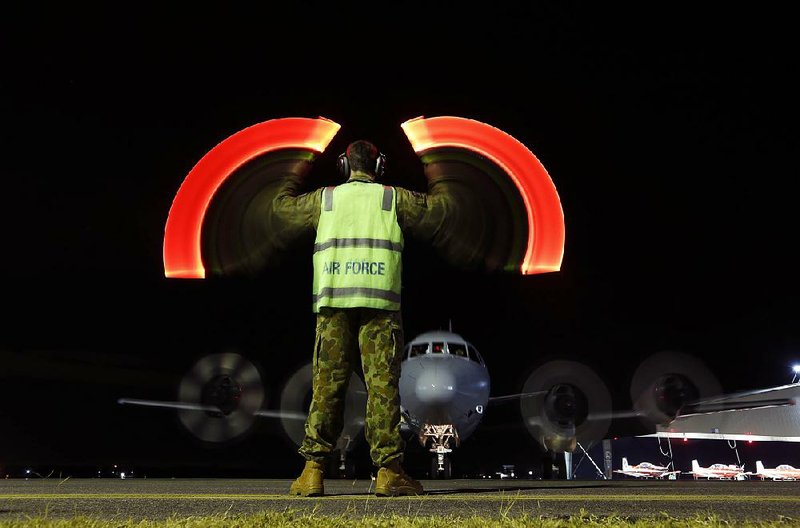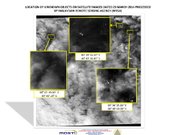KUALA LUMPUR, Malaysia - New satellite images taken in recent days show more than 100 objects - some as long as 75 feet - that may have come from missing Malaysia Airlines Flight 370, Malaysian Defense Minister Hishammuddin Hussein said Wednesday.
The images, which Hishammuddin called the “most credible” lead so far in the search for the vanished Boeing 777 airliner, revealed items in the water more than 1,000 miles from Perth, Australia. The images, taken Sunday, were provided by France’s Airbus Defense and Space company.
France gave Malaysian authorities the new information Tuesday, and an analysis by Malaysia’s remote-sensing agency identified 122 objects. The Malaysian government said it has since shared the information with the Australian authorities leading the search in the southern Indian Ocean.
Clouds obscured the latest satellite images, but dozens of objects could be seen in the gaps. Hishammuddin said some of them “appeared to be bright, possibly indicating solid materials.”
“We cannot tell whether the potential objects are from MH370,” Hishammuddin said. “Nevertheless, this is another new lead that will help direct the search operation.”
Airbus said five of its Earth observation satellites - some equipped with high-resolution cameras, others with radar - were assisting in the search for Flight 370 and would do so as long as needed.
The images mark the fourth set of data from satellites showing objects that may have come from the plane drifting in the remote waters of the southern Indian Ocean.
A new surge of planes and ships arrived to assist in the growing hunt for the missing aircraft, which officials have said went down in the southern Indian Ocean with 239 people on board on March 8, far off its planned flight path from Kuala Lumpur to Beijing.
Low-flying planes spotted potential debris as recently as two days ago, but the search had to be put on hold Tuesday because of bad weather.
Australian Prime Minister Tony Abbott said Wednesday that searchers have been able to see a “considerable” number of objects. “Bad weather and inaccessibility has so far prevented any of it being recovered, but we are confident that some will be,” he said.
Aircraft and ships from six countries - Australia, New Zealand, the United States, Japan, China and South Korea - tried to cover tens of thousands of square miles Wednesday. The hurdles remain daunting. The area is a four-hour flight from Perth, the base of the Australian-led search. Because of fuel constraints, planes have only two to four hours to look before having to turn back.
Seven planes were flying in the area Wednesday, with four more on the way, according to the Australian Maritime Safety Authority. After a number of days when only the Royal Australian Navy’s HMAS Success was available to follow up on any sightings in the sprawling area, four Chinese ships arrived to join the hunt.
Malaysian Prime Minister Najib Razak announced Monday night that a new analysis of satellite data showed that the plane’s voyage ended somewhere in the remote reaches of the Indian Ocean, dashing hopes that passengers and crew members survived.
That data greatly reduced the search zone to an area estimated at 622,000 square miles, about the size of Alaska. Wednesday’s search focused on a 31,000-square-mile swath of ocean about 1,240 miles southwest of Perth.
“We’re throwing everything we have at this search,” Australian Prime Minister Tony Abbott told Nine Network television.
“This is about the most inaccessible spot imaginable. It’s thousands of kilometers from anywhere,” he later told Seven Network television. “We will do what we can to solve this riddle.”
The challenge of this stage in the search was apparent Wednesday. Observers saw three objects in the area late in the day: two items that were likely rope, plus a blue object. When the planes flew overhead again to take a look, they could not relocate the objects.
In addition, the search area Wednesday included the location where satellites picked up signs of the 122 objects. Yet aside from the three objects spotted briefly, there were no other sightings of debris.
Though officials believe they know roughly where the plane is, they don’t know why it disappeared shortly after takeoff. Investigators have ruled out nothing - including mechanical or electrical failure, hijacking, sabotage, terrorism or matters related to the mental health of the pilots or someone else onboard.
The search for the wreckage and the plane’s flight-data and cockpit-voice recorders is a major challenge. It took two years to find the black box from Air France Flight 447, which went down in the Atlantic Ocean on a flight from Rio de Janeiro to Paris in 2009, and searchers knew within days where that crash site was.
The batteries on the recorders’ “pingers” are designed to last 30 days. After that, the pings begin to fade in the same way that a flashlight with failing batteries begins to dim, said Chuck Schofield of Dukane Seacom Inc., a company that has provided Malaysia Airlines with pingers in the past. Schofield said the fading pings might last five days before the battery dies.
The Australian Maritime Safety Authority, which is coordinating the southern search operation, said a U.S. pinger locator arrived in Perth along with a Bluefin-21 underwater drone. The equipment will be fitted to the Australian navy ship the Ocean Shield, but the authority could not say when they would be deployed.
The listening device needs to be towed far underwater behind a ship traveling scarcely faster than a person walking, so it cannot search large areas quickly. To detect the pings reliably, the device must be within about a mile of the plane’s black box.
“The idea of searching a potential area larger than the state of Texas is simply daunting,” said Peter Goelz, a former managing director of the U.S. National Transportation Safety Board. “We will need an extraordinary stroke of luck to recover floating debris, let alone identify where the wreckage is. It is just overwhelming the challenge that the investigators are facing.”
Malaysia has been criticized over its handling of one of the most perplexing mysteries in aviation history. Much of the most strident criticism has come from relatives of the 153 missing Chinese passengers, some of whom expressed anger that Malaysia essentially declared their loved ones dead without recovering a single piece of wreckage.
At a hotel banquet room in Beijing on Wednesday, a delegation of Malaysian government and airline officials explained what they knew tothe relatives. They were met with skepticism and even ridicule by some of the roughly 100 people in the audience, who questioned how investigators could have concluded the direction and speed of the plane. One man later said he wanted to pummel everyone in the Malaysian delegation.
“We still have hope, but it is tiny, tiny,” said Ma Xuemei, whose niece was on the flight. “All the information has been confusing and unreliable.”
In China, anger at the Malaysian government continued to swell, with celebrities vowing to boycott the country. Chinese on the Internet also wondered whether passengers from another country, such as the United States, would have been treated better.
In Beijing on Tuesday, relatives of Chinese passengers on the missing flight marched to the Malaysian Embassy in Beijing to demand answers.
China, which has warships and an icebreaker in the search zone, has backed the demands of the Chinese families who want detailed information on how Malaysia concluded that the jet went down - details that Hishammuddin said Malaysia handed over Wednesday.
But Hishammuddin also expressed exasperation, saying Chinese families “must also understand that we in Malaysia also lost our loved ones,” as did “so many other nations.”
Information for this article was contributed by Jia Lynn Yang and William Wan of The Washington Post; by Rob Griffith, Todd Pittman, Eileen Ng, Scott McDonald, Christopher Bodeen, Didi Tang, Kristen Gelineau, Justin Pritchard and Nick Perry of The Associated Press; and by Keith Bradsher, Nicola Clark, Michelle Innis and Kirk Semple of The New York Times.
Front Section, Pages 1 on 03/27/2014




